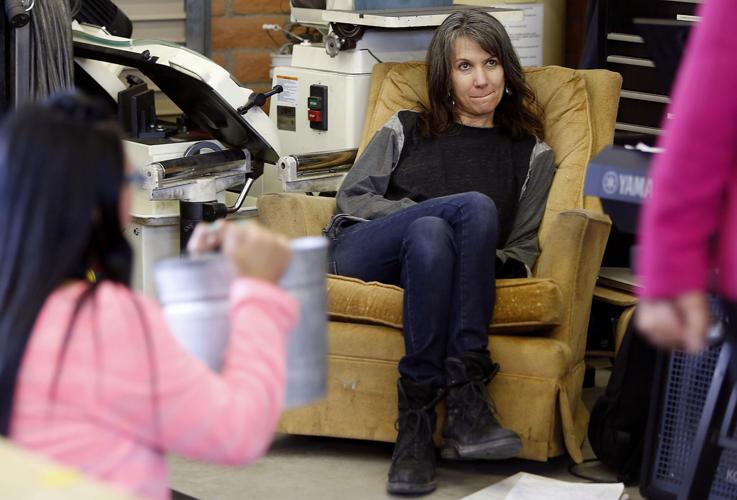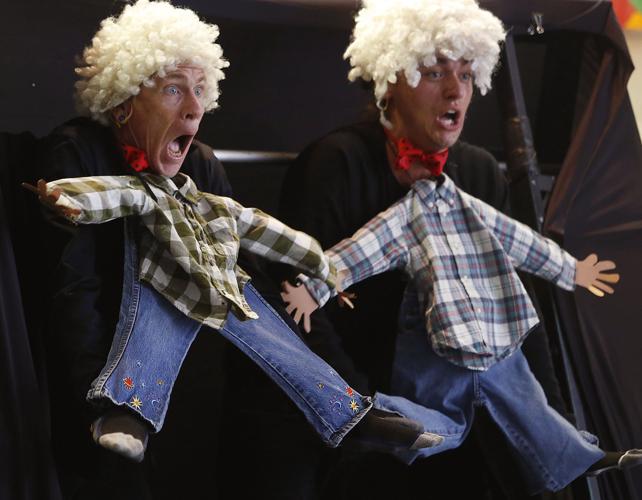Budding writers take their seats on the floor of the crowded cafeteria. They wait anxiously — fidgeting, talking and dancing to live music — never taking their eyes off the stage, where Stories that Soar is about to turn their words into plays.
A hush settles over the Robison Elementary School children as the performances begin. Excitement, laughter, and sometimes tears follow as their tales about family, dreams, love, death and even zombies, come to life.
This is a familiar scene for Stories that Soar. The nonprofit organization, a program of Literacy Connects, travels to schools throughout Southern Arizona, to give voice to children’s imaginations by performing their stories.
It starts with a visit to the school, where, through the voice of an actor, a “Magic Box” tells the kids how hungry it is for their original writings.
The box settles in for about three weeks. Children stuff it with stories.
About two weeks after the box is picked up, it’s show time.
GETTING STARTED
As she helped grade papers in her son’s first grade classroom at Lineweaver Elementary, Sharon O’Brien knew she could do more for the school — and for the kids.
So, the theater major at the University of Arizona got permission to put on a play with her son’s class.
“I rediscovered my passion for theater,” she said.
But, she still wanted to do more. She knew there had to be a way to bring the resources together to help inspire more students.
It turned out, her friend, Meg Breshears, felt the same way.
They wanted to empower kids through theater. So, Breshears introduced O’Brien to Sonia Teder-Moore, who was working on an idea to have children write stories to feed a magic box. Those stories would then be performed by actors for the students.
The concept was brought to life at the UA in 2001, as a small project in the women’s collaborative theater class.
They used theater students as actors, and had their first performance at Sam Hughes Elementary School.
Inspired to continue to build the program, the women applied for and received a three-year research project grant for $30,000, and developed their masters thesis with it.
The program existed at the UA for four years, O’Brien said. When she was getting ready to graduate with her master’s degree, and funding was running out, they began talking with the university about what to do with the program. The university wanted to keep it, but the women wanted it to grow.
“We saw potential,” O’Brien said.
Since projects created at the university are technically owned by the university, they sought help from the office of Technology Transfer to create an agreement so they could take it. Their next step was being accepted into the McGuire Entrepreneurship Program in the Eller College of Management. After pitching their idea, they were admitted to earn their associate MBA.
“We did really well,” O’Brien said. “I learned a lot. We launched our business the year we graduated.”
Around 2005 they incorporated as a nonprofit called Sharmoore Children’s Productions. That first year, they performed five shows.
In 2011, Sharmoore — as Stories That Soar — merged with Reading Seed and Literacy Coalition to create Literacy Connects.
A WEALTH OF STORIES
Stories That Soar works with schools to get kids excited about writing.
“We kick it off in a creative way,” said O’Brien, the nonprofit’s artistic director and remaining founding member. “We’re there to support that teachers work hard teaching kids how to write. We find the magic box helps teach why we write — to be heard and to share ideas.”
The magic box is not a picky eater. Students can feed it stories on any topic.
“We frequently get hard and or sad stories. Most commonly, we receive sad stories from children dealing with a loss of a family member or pet,” said Dallas Thomas, production manager. “However, we’ve received and performed stories about children being taken from their family by CPS, politics, border issues, death, bullying and more. We make it a point to not shy away from difficult stories when we receive them. Students trust the magic box as a safe confidant, and share many personal stories. It’s an outlet, both creative and at times, very emotional.”
A memorable one for O’Brien was written by a first grader. “If I am myself, is there another me? So, I looked under the bed, there was a monster and it chased me and I was scared,” O’Brien quoted. “Here’s this little six year old asking metaphysical questions and she’s exploring demons while looking for herself and she takes a hose and washes them away. … If you take time to think about it, these kids are writing about universal things. We don’t always see them as deep thinkers.”
After the three weeks, O’Brien reads each story fed to the box — usually several hundred — and narrows the stack down to about 100, which are then separated and sent home with the actors. Their job is to select two to four stories, and come back with concepts on how they would be performed.
TOUGH CHOICES
In a workshop behind O’Brien’s mid-Tucson home, several actors sit in a circle on the ground, each one with a stack of papers in front of them.
“I love this one. ‘The Man with the Big Head.’ I’m thinking puppet show with red curtains,” actor Greg Colburn said.
Each one takes turns talking about how they’d perform the tales they chose, as O’Brien keeps a list on a white board.
Actor Anel Schmidt describes “The Only Girl,” as a bilingual family drama. A soft one with movement.
The white board is full. More than 980 stories were submitted for this show, and the actors have to choose about 20.
“It’s so hard,” said actor Cyndi LaFrese. “If we need to let this one go, it’s fine, but, it’s awesome. They’re gonna dance ‘The Hustle’ and ‘Stayin Alive.’ But, honestly, that’s what it is. It’s fun and it’s fluff. It was my relief piece, since I went with heavier stuff this show.”
THE CAST
Stories that Soar employs a rotating cast of about 21 part-time professional actors, and a full-time production manager. Seven actors perform in each show.
“I love getting to work with these really passionate people,” O’Brien said. “I feel so thankful we believe in this mission and get to create something meaningful together.”
The actors feel the same way.
“I love that we get a glimpse into the authors’ worlds, their imaginations and their real life experiences, their fears, their secret wishes, their heartbreak,” LaFrese said. “It can get real, and I love that we can give a voice to those stories too.”
“My favorite part of working for Stories That Soar is getting to go to work and be like, ‘This is my job. We are adults playing in the garage, and this is my job,’” said Luke Murray, 21. “Not everyone gets to go to work and say that they are happy doing what they are doing.”
Fun is part of it. But, the real joy comes from knowing they are making an impact on the children.
“Kids go from not liking to write one bit to loving to write, even for homework,” Murray said.
Seeing the excitement on a child’s face when their story is performed for the whole school is a great feeling, Murray said.
“I have heard over and over that we pick the stories ‘that needed to be chosen,’ the struggling writers, the quiet kids, the ones no one expected,” LaFrese said. “I think the impact goes beyond writing, which in and of itself is so important already. I think seeing their story on stage boosts their self esteem and empowers them to think that they can do anything.”
The most memorable story for LaFrese was by a girl from the Arizona Schools for the Deaf and the Blind about her experience at a summer camp empowering kids with prosthetic limbs. She wasn’t very interested in writing until she saw her story performed.
“Her reaction during the show was absolutely priceless and in the years after, we got to see her writing and creativity blossom as she wrote more stories for the Magic Box,” LaFrese said.
REHEARSAL TIME
Boxes are moved from one side of the room to the other and masks are handed out to the actors as they read through a story about a boy trying to convince his friends that zombies are real.
Props are basic. Wood boxes, ladders and fabric become trees, mountains, beds, dragons, dreams — anything one can imagine.
“Using a minimal approach engages the audience more,” O’Brien says. “If you suggest a costume, the audience fills in the rest and are involved in the process.”
Zombie noises and screaming can be heard as cast members act out a fight scene.
“Definitely getting cleaner. Mike, you came in really fast. I’m not buying your zombie moves yet,” O’Brien said, as she gets up to demonstrate slower zombie moves. “We also need a little more tension in the fight scene.”
FUNDING
Each show costs about $6,000 to produce, so there is a fee for the group’s services.
The school host fee ranges from $2,500 to $5,000. To cover the rest, O’Brien said they seek funding through grants, business sponsors, foundations and individual donors. Key funders are Tucson Pima Arts Council, Arizona Commission on the Arts, Stocker Foundation and Helios Foundation (as part of the Literacy Connects Infusion Project), O’Brien said.
“The bulk of the expense goes towards paying the production manager, artistic director, seven actors, stage manager, musicians, tech and evaluation,” O’Brien said. “A small portion goes towards production costs. The $6,000 does not pay for indirect costs associated with running the organization.”
STANDING OVATION
At the end of every show, O’Brien asks students who wrote stories to stand.
At Robison Elementary School, about 95 percent of the kids stand.
The cheers are deafening, as the children are acknowledged.
O’Brien then thanks the teachers.
“Without you encouraging literacy, this wouldn’t happen,” O’Brien says. “Give a hand to the teachers.”
After that, the authors of stories that were performed and illustrators of pictures that were shown, are called to the stage. Each one takes a handful of confetti on their way up.
“Without an idea, without a plot,” the cast sings. “Without some action, a story it’s not.”
With that, a burst of color shoots into the air as students throw their confetti.
That’s one of O’Brien’s favorite parts.
“I love nothing more than seeing their faces and meeting these little people,” O’Brien said. “And to see them walk up on that stage and know you’re acknowledging them.”















